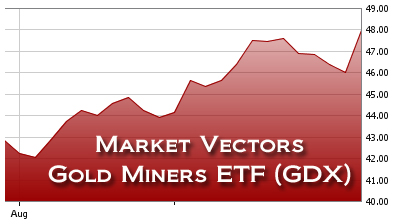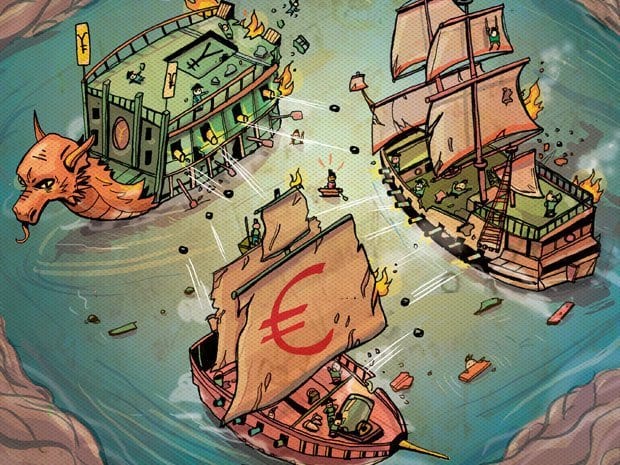
Dear Readers,
The World’s Secret
We’re at war. But not one that’s fought with guns and missiles; one that is fought with currency.
Currency wars are fought globally in all major financial centers by bankers, traders, politicians and automated systems – and the fate of the economies and their affected citizens hang in the balance.
A “currency war” is a fight between countries to achieve a lower exchange rate for their own currency. In other words, its competitive devaluation.
In short, the cheaper your currency, the more money you attract from foreign entities; this leads to increased exports, growth, and job creation.
The dollar, the yuan, and the euro, are the three super power currencies leading the global currency war. The one on top will be the one that devalues its currency the fastest.
However, devaluation and currency wars never produce either the growth or the jobs that are promised, but they reliably produce inflation.
At the end of the day, one thing is for certain: The price of gold will rise (as it always has), to match the continual, yet competitive, nature of currency devaluation.
America’s Gold Wiped Out
No one truly understands just how out of hand America’s finances have become. America has, in fact, run trade deficits large enough to wipe out its gold hoard under the old rules of the game – the old rules being brought back to light given the world’s current financial conundrum.
If we were to think of America’s current finances under an evolved Bretton Woods system, China’s redemption of US Treasury notes would be more than enough to wipe out the entire gold supply of the U.S. and more. And this is perfectly plausible if we were under the rules of Bretton Woods.
While this may seem extreme, this is exactly how most of the world monetary system worked up until 40 years ago. It’s no wonder why the U.S Republican party recently called for a commission to look at the merits of a gold standard.
Sixty years ago the US had over 20,000 tons of gold. But because of consistently large trade deficits, it dropped to 9000 tons. In 21 years, US gold reserves dropped 11,000 tons of gold that mostly went to a small number of export powerhouses to make up for its trade deficits.
The Truth About Printing
Every day journalists and reporters talk about printing dollars, yet they have no clue what’s really happening.
But I am going to tell it to you straight.
I’ve mentioned this a few years ago in my letter, “Two Birds, One Stone: The American Secret.” Prior to 2011, no one was winning the currency war. China was experiencing a surplus and the US was negative. So the U.S. did everything it could, including persuasions through the G20, to convince China to appreciate their currency to balance out the major trade deficit.
But China wouldn’t allow their yuan to appreciate because it would hamper their own growth. Why would they hamper their growth for the benefit of a competing country?
As a result, the United States, empowered by its world reserve status, pulled out its secret weapon: Quantitative Easing (QE).
The United States effectively devalued its own currency by increasing its own money supply, forcing inflation onto China.
It now had an edge on this currency war.
China’s Inflationary Worries
When a Chinese exporter ships goods abroad and earns dollar or euros, it must hand over those currencies to the People’s Bank of China (PBOC) in exchange for yuan at a fixed rate by the bank.
When an exporter needs dollars or euros to buy foreign materials from other importers, it can get them; however, the PBOC only makes enough dollars or euros available to pay for the imports and no more. The bank keeps the rest.
This is how China is able to maintain a pegged exchange rate with the United States.
The process of absorbing all the surplus dollars entering the Chinese economy, especially after 2002, produced a number of unintended consequences.
The problem was that the PBOC did not just take the surplus dollars, but they purchased them with newly printed yuan. It meant that as the Fed printed dollars and those dollars ended up in China to purchase goods, the PBOC had to print yuan to soak up the surplus.
In effect, China had outsourced its monetary policy to the Fed. As the Fed printed more, the PBOC did too to maintain the pegged exchange rate.
The United States’ plan was working.
Not What You Believe
China was a booming economy and had bounced back nicely from the 2008 crisis. The United States was a struggling economy with little chance of near-term inflationary pressures.
In the short-term, QE hurt China more than it did the United States.
If China maintained their peg to the dollar, it was either appreciate their currency or experience higher inflation.
From June 2010 through January 2011, the yuan had appreciated around 4% and Chinese inflation was moving at a 5% annualized rate. That means the total increase in the Chinese cost structure was a total of 9%. Projected over several years, the dollar would decline over 20 relative to the yuan in terms of export prices.
QE was working.
The United States is now beginning to win the currency war with China.
China is experiencing inflation and yuan appreciation. Headlines continue to show that China’s growth is slowing and calls of a Chinese bubble are being talked about worldwide. China’s manufacturing just shrank for the first time in nine months.
Still think QE didn’t do anything?
The US trade deficit narrowed to $42.9bn in June, the smallest in 18 months. Exports increased 0.9 per cent to a record $185bn as US companies sold more consumer products, automotive parts, industrial supplies and capital goods abroad.
But there’s a big problem. When the US prints dollars and another country tries to peg its currency to the dollar, that country ends up printing local currency to maintain the peg, which causes inflation. That means as the Fed prints, the world as a whole experiences inflation.
Countries around the world are feeling the effects of this currency war. It’s created higher food prices in Egypt and stock bubbles in Brazil.
Printing money means that U.S. debt is devalued so foreign creditors get paid back in cheaper dollars. The devaluation leads to higher unemployement in developing economies as their exports become more expensive to Americans.
While inflation isn’t so bad on the home turf, developing countries experiencing even a slight rise in prices are feeling the tremors. Rising food prices for us are an inconvenience, but for those of smaller developing nations, it’s a matter of life and death.
As a Canadian, I hear people everyday around me loving how strong the Canadian dollar is. But in the long term, it does more harm than good.
The competitive devaluation of the dollar has caused the Canadian trade deficit to soar; it reached $1.8 billion in June, an almost twofold increase from the level a month earlier.
As a resource-rich nation, we traditionally have had trade surpluses, meaning we sell more to the world than we buy.
But since the recession, the economy has been consistently in trade deficit conditions – as a result of the American printing press. In the last four years, Canada has only posted a significant trade surplus eight times.
Uh Oh
Bernanke just announced there is a great chance of another round of stimulus at this week’s Jackson Hole Summit. The Fed has printed over $2 trillion yet unemployment remains at low levels. But China is beginning to lose ground on the currency war.
Will the next round of QE be the bullet used to cripple China? Bernanke has made it clear that stimilus is around the corner given the ‘grave concerns” of unemployment.
Previous rounds of QE have already sent gold to record-breaking prices. Imagine what it will do this time around.
The fundamentals for gold have never been better.
They’re printing dollars. They’re printing Euros. They’re printing Yen. They’re printing Sterling. And the Chinese has to print RMB to keep up.
A few weeks ago in my letter, “Your Last Chance,” I said that August may be your last chance at gold stocks bargain hunting.
Take a look at this chart:

But don’t worry, you haven’t missed the boat; gold is about to breakthrough.
Bloomberg just reported that hedge funds “boosted bets on rising commodities to the highest in 15 months.”
Investors added another $1.47 billion to commodity funds in the week ending on August 22 – the third inflow of money in the past four weeks. Of that, $1.36 billion went directly toward precious metals: gold, silver, platinum, and palladium.
Data shows that traders are the most bullish they’ve been since last year. If we stablize at these levels, a lot of neutral players in the gold market will become buyers.
Conclusions
I find it absurd that journalists and reporters continue to talk about gold as if it didn’t mean anything. Most of them have never even bought gold, or anything associated with it.
Heck, the only stock they own is stock of their employers as part of an employee stock option plan.
Gold, along with silver, is about to breakthrough and that means quality gold and silver companies are going to see a major surge. The next surge in gold will prove to everyone that the rise in gold is real and here to stay.
Sentiment amongst dealmakers is getting a lot better and funding is back on the table.
The money will soon flow at an aggressive pace. I won’t be standing on the sidelines. Markets are closed tomorrow, so be prepared for Tuesday.
Until next week,
Ivan Lo
Equedia Weekly

Questions?
Call Us Toll Free: 1-888-EQUEDIA (378-3342)
Disclosure: I am long gold and silver through ETF’s and bullion, as well as long both major and junior gold and silver companies. Remember, past performance is not indicative of future performance. Just because many of the companies in our previous Equedia Reports have done well, doesn’t mean they all will. F
Disclaimer and Disclosure
Equedia.com & Equedia Network Corporation bears no liability for losses and/or damages arising from the use of this newsletter or any third party content provided herein. Equedia.com is an online financial newsletter owned by Equedia Network Corporation. We are focused on researching small-cap and large-cap public companies. Our past performance does not guarantee future results. Information in this report has been obtained from sources considered to be reliable, but we do not guarantee that it is accurate or complete. This material is not an offer to sell or a solicitation of an offer to buy any securities or commodities.
Furthermore, to keep our reports and newsletters FREE, from time to time we may publish paid advertisements from third parties and sponsored companies. We are also compensated to perform research on specific companies and often act as consultants to many of the companies mentioned in this letter and on our website at equedia.com. We also make direct investments into many of these companies and own shares and/or options in them. Companies do pay us to advertise on our website and we often distribute our reports on featured companies. While we are never paid to write a rosy and positive report on any company, we do market our reports using the advertising fees paid for by our featured companies.
This process allows us to continue publishing high-quality investment ideas at no cost to you whatsoever. Our revenue is generated by sponsor companies and we grow our readership by using the advertising fees we charge to distribute our reports. This helps both Equedia and our client companies gain exposure and allows us to provide you with our research at no cost.
Therefore, information should not be construed as unbiased. Each contract varies in duration, services performed and compensation received.
If you ever have any questions or concerns about our business or publications, we encourage you to contact us at the email or phone number below. Equedia.com is not responsible for any claims made by any of the mentioned companies or third party content providers. You should independently investigate and fully understand all risks before investing. We are not a registered broker-dealer or financial advisor. Before investing in any securities, you should consult with your financial advisor and a registered broker-dealer. The information and data in this report were obtained from sources considered reliable. Their accuracy or completeness is not guaranteed and the giving of the same is not to be deemed as an offer or solicitation on our part with respect to the sale or purchase of any securities or commodities. Any decision to purchase or sell as a result of the opinions expressed in this report OR ON Equedia.com will be the full responsibility of the person authorizing such transaction.
Please view our privacy policy and disclaimer to view our full disclosure at http://equedia.com/cms.php/terms. Our views and opinions regarding the companies within Equedia.com are our own views and are based on information that we have received, which we assumed to be reliable. We do not guarantee that any of the companies will perform as we expect, and any comparisons we have made to other companies may not be valid or come into effect. Equedia.com is paid editorial fees for its writing and the dissemination of material and the companies featured do not have to meet any specific financial criteria. The companies represented by Equedia.com are typically development-stage companies that pose a much higher risk to investors. When investing in speculative stocks of this nature, it is possible to lose your entire investment over time. Statements included in this newsletter may contain forward looking statements, including the Company’s intentions, forecasts, plans or other matters that haven’t yet occurred. Such statements involve a number of risks and uncertainties. Further information on potential factors that may affect, delay or prevent such forward looking statements from coming to fruition can be found in their specific Financial reports.
Equedia Network Corporation is also a distributor (and not a publisher) of content supplied by third parties and Subscribers. Accordingly, Equedia Network Corporation has no more editorial control over such content than does a public library, bookstore, or newsstand. Any opinions, advice, statements, services, offers, or other information or content expressed or made available by third parties, including information providers, Subscribers or any other user of the Equedia Network Corporation Network of Sites, are those of the respective author(s) or distributor(s) and not of Equedia Network Corporation. Neither Equedia Network Corporation nor any third-party provider of information guarantees the accuracy, completeness, or usefulness of any content, nor its merchantability or fitness for any particular purpose.













Since the essay “America Gold Wiped Out” Sept 2012, London Gold price has fallen from $1700 to $1450 today. It appears America Government has made money and the Bull has not. I have recently been buying gold only asset ETF’s with monthly payout of gold companies dividend and option writing earnings. They are at an insane value paying out about 20% annual today. Even though the dividend rate has fallen over the past year, and gold is closer to a low, the dividend payout should remain nearly washed out and when gold recovers in 2014 or 2015 the assets of the ETF will rally providing a nice capital return. Adding the two, I believe the gross return will likely be as high as 100% by end of 2015.